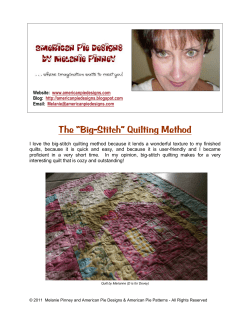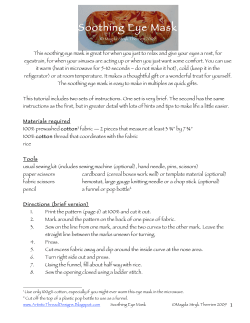
Document 101363
TECHNICAL BULLETIN Reducing Needle Cutting on Knits Needle cutting is the breaking of yarns in the fabric as the needle enters the seam. On knit that are made with interlooping yarn constructions, a cut yarn will result in a “run” along the seam line. Therefore, when the needle enters the seam, the needle point should not cut the yarns but push them aside as it penetrates the fabric. Below is a checklist that will aid in reducing needle cutting. NEEDLES & THREAD • Use a ball pointed needle as small as possible. A ball pointed needle should not cut the yarns in the fabric as the needle penetrates the seam but shift the yarns to one side. This also requires a small diameter thread. On some classes of needles, there are different types of ball points available. Make sure the type of ball point matches the size of the yarn in the fabric. Too large of a ball point will burst the a knit fabric made from very fine yarns. Too small of a ball point will pierce and possibly cut or weaken larger yarn sizes used in sweaters, etc. New Round • Fine Medium Heavy A small diameter thread with a high tenacity is generally required to give the required seam strength. Typical thread types and sizes used for seaming knits would include: Weight of Fabric Light weight knits Medium weight knits Heavy weight knits Thread Type and Size T-18 Wildcat® Pus or T-21 Perma Spun® or Excell® T-24 Wildcat® Pus or T-21 Perma Spun® or Excell® T-35 Wildcat® Pus or T-21 Perma Spun® or Excell® Metric Ndl Size 55, 60, 65, 70 70, 75, 80 90, 100 Note: Perma Spun® is A&E’s global brand of spun polyester and Excell® is A&E’s CAFTA / NAFTA brand. In most cases, high performance threads are not necessary when sewing knit garment with an overedge or coverstitch construction. However, there may be cases where a high tenacity, high performance thread is required. A&E’s T-18 and T-24 Perma Core® threads have a very high tenacity and are recommended on demanding operations that require good sewability and seam performance. Page 1 TECHNICAL BULLETIN • Use a tapered blade needle with a ball point if it is available. A tapered blade needle allows the use of the smallest possible needle with minimum needle breakage. • Inspect the needles at regular intervals and replace them if they show signs of having a sharp or burred point. Sometimes the sewing machine can be out of adjustment allowing metal to metal contact that will damage the point. Readjust the sewing machine if necessary to minimize this condition. • Check for signs of needle heat that may be melting the fibers. If needle heat is identified as the problem by observing melted fibers around the needle hole, reduce the needle heat by one of the following methods: a) use a double grooved needle if available; b) make sure the thread has a good lubricant on it; and c) use some type of needle cooler. OTHER MACHINE PARTS • Check for any sharp edges on the needle plate, feed dog, and presser foot. Slightly bevel or radius the top of the needle plate if necessary. Remove all sharp edges that might snag the fabric as it is being sewn. Care should be taken not to remove too much to allow excessive flagging or the material. • Use minimum presser foot pressure so the fibers in the fabric are allowed to shift as the needle penetrates the seam. Sometimes a presser foot with a special plunger or yielding section is used to reduce the pressure on the seam at the needle. OTHER CAUSES OF FABRIC DAMAGE • Not all fabric damage attributed to needle cutting is caused by the needle during sewing. Many times the “cuts” are created before the sewing process. A way of determining if the problem is being caused by the needle or something else is by evaluating: Are the holes occurring at the seam where the needle enters the seam or at other locations away from the seam. If the “cuts” are found away from the stitch line, the holes could be caused by: a) staple holes caused by attaching the marker on the lay before cutting; and b) other rough surfaces that the fabric might come in contact with during handling. FABRIC STORAGE • Fabric storage is very important when sewing 100% cotton piece goods. Some fabrics can dry out and become brittle if they are not stored properly. If you suspect that the fabric is particularly susceptible to needle cutting, try the following: - Try conditioning the fabric in a humidity chamber prior to the sewing process. - If this helps, store your piece goods in a controlled environment. - Try not to pre-heat the garment pieces prior to sewing which might dry out the fabric. Cotton yarns are actually stronger when they are wet. - Ask your fabric supplier or an independent test company to test the strength of the fabric and evaluate if the fabric has been finished properly. Even the best fabric suppliers sometime make inferior piece goods. Page 2 TECHNICAL BULLETIN TROUBLE-SHOOTING LOGIC Below is a basic logic used to determine the cause of needle cutting. 1. Is the needle cutting occurring on most sewing operations on the garments being sewn? If so, the problem is probably related to the fabric. Make sure the fabric has been finished and conditioned properly. 100% cotton fabrics usually loose strength when they dry out. On solution is too have a humidity controlled conditional area where the cut parts are moved prior to going to the sewing floor. 2. Is the needle cutting only occurring on a few sewing operations? If yes, can you determine if the needle cuts are on the top or bottom ply being sewn? If the needle cuts are always on either the top or bottom ply, then most likely the problem is NOT needle cutting but some other part of the machine that is damaging the fabric. Check for burrs or sharp surfaces on the needle plate, presser foot, folder, etc. 3. Is the needle cutting on a few sewing operations and intermittent on both the top and bottom plies of fabric being sewn? If yes, then the problem most like is needle cutting. Check the needle points for damage? Check to make sure the correct size and needle point are being used for the fabric. Using a smaller needle is always the first step to needle cutting unless the needle points are being damage during sewing. 4. If the needle points are being damaged, what should you look for? Check to make sure that the needle point never makes contact with any metal surface in the sewing machine like a needle guard, needle plate, etc. If so, readjust the sewing machine to eliminate the metal to metal contact. SUMMARY As you can see from the preceding comments, many factors can contribute to needle cutting or fabric damage. In many cases, there is not a single solution that will resolve a needle cutting problem. Each case of needle cutting must be examined to determine the appropriate steps that must be taken to minimize or eliminate the problem. If you need additional assistance, please contact your local A&E representative for assistance. Page 3
© Copyright 2025









